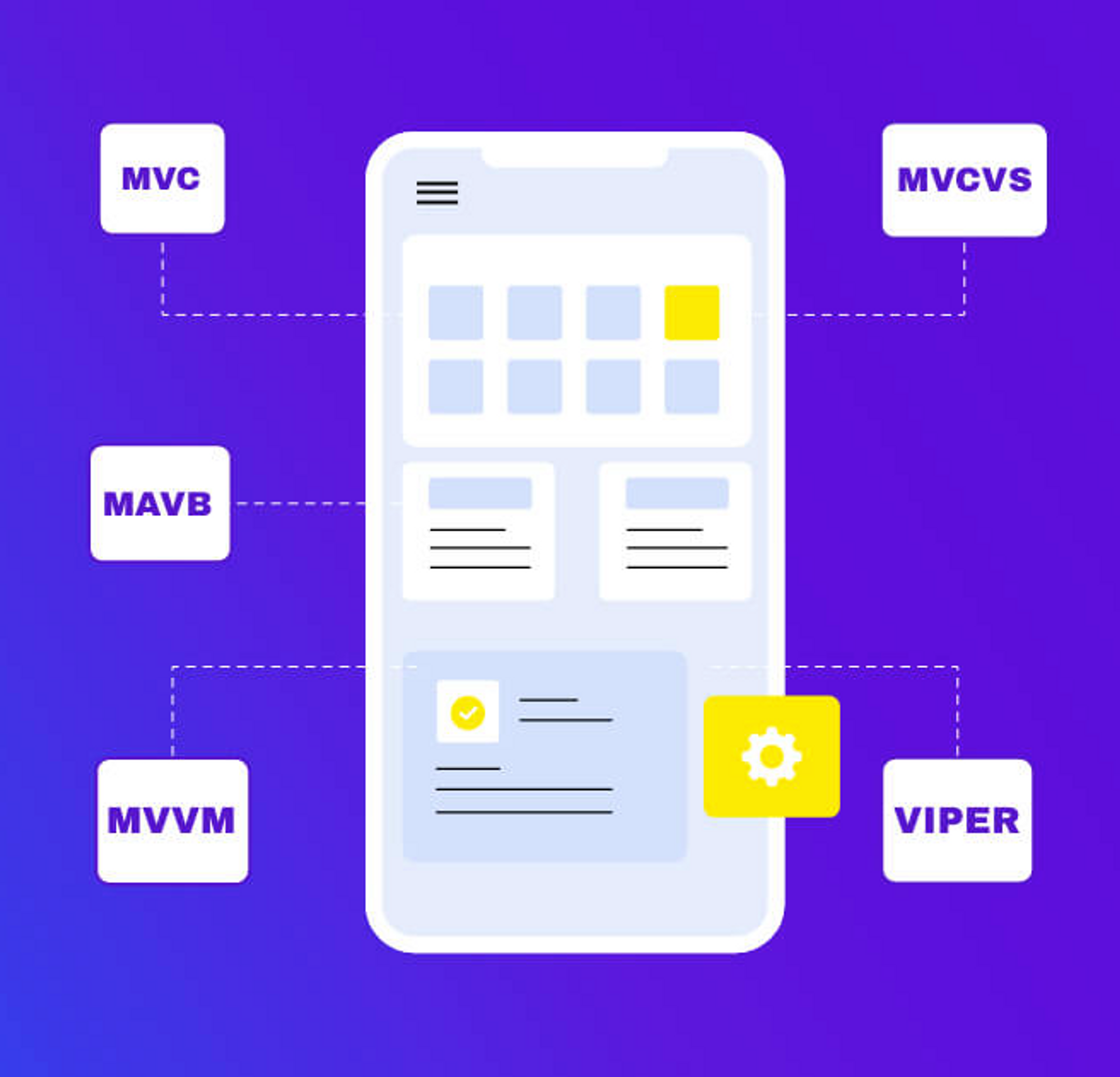An iOS application architecture describes the patterns and techniques to use design and build an app. We can call it a roadmap or best practices to follow.
An app without following any architectural pattern is like following a path without defining any goal.
When we develop iOS applications we need to follow the different architectural patterns for the different use cases. The most popular architectural design patterns are:
- MVC - Model View Controller
- MVP - Model View Presenter
- MVVM - Model View ViewModel
- VIPER
MVC
It is considered one of the most popular iOS architecture in-app architecture designs. It is easy to use and highly recommended by Apple itself. iOS, macOS, and watchOS use this as a default architecture. Its design patterns separate the presentation layer from the business logic.
The Model View Controller architectural pattern differentiates concerns into 3 classifications:
- Model: It manages stores and data
It represents databases and can be illustrated the concept by using local storage on a browser.
- View: Graphical User Interface
It represents data in a form of a chart, diagram, or table. It has all the desired functionality to interact with the user through click buttons.
- Controller
Known as the brain of the application. It establishes a connection between the model and the view. To retrieve the data, it converts all the inputs from the view to demands in the model. It works like this:
- Receives input from view and translates the input through logic
- The model receives all the data
- The received data passes from the model back to view for the display
Attributes of MVC
- A much popular architecture in web applications
- It comes with good compatibility with web application architecture and divides responsibilities between the client and server
- Good for planning development
- Keep unnecessary dependencies at bay
- Extendable code and code reusing
- Can be maintained and modified easily
- Seamless Rails on Ruby support
- Model, View, Controller, each part can be tested independently
MVP
MVP is an architectural pattern, a derivation of the Model–View–Controller. It's represented by three distinct components: Model, View, and the Presenter.
It was engineered to facilitate automated unit testing and improve the separation of concerns in presentation logic.
Components:
- Model is an interface responsible for the domain data (to be displayed or otherwise acted upon in the GUI)
- View is responsible for the presentation layer (GUI)
- Presenter is the "middle man" between the Model and the View. It reacts to the user’s actions performed on the View, retrieves data from the Model, and formats it for display in the View
MVVM
The Model View ViewModel is also a design pattern known for developing user interfaces. It is based on the pattern “Model View Controller” (MVC) and the applications based on MVVM patterns use multiple capabilities available on WPF, Silverlight Desktop/web, and Windows.
The Model View ViewModel (MVVM) pattern is a design pattern most commonly used for creating user interfaces. It is derived from the popular “Model View Controller” (MVC) pattern. Microsoft expression products are also based on MVVM
Here are the MVVM Principles:
- The Simplicity Principle: Each view has a single ViewModel and ViewModel is only responsible to service a single View.
- The Blendability Principle: Expression blend support
- The Designability Principle: The ViewModel should supply Design Time Data
- The Testability Principle: The ViewModel and Models should be testable.
Attributes of MVVM
- Known for its maintainability and keep remain agile to release successive versions quickly
- Comes with high extensibility and the ability to tweak the code (replace and add)
- Easy testing ability paves the way to write unit tests against a core logic
- Comes with a transparent interface to the view controller. It interacts with the view layer with the model layer for transparent communication.
VIPER
It is considered an adaptation of the Clean Architecture of iOS applications. It consists of View, Interactor, Presenter, Entity, and Routing. It is specially customized to build components around different user cases.
Generally, it requires different components, which makes it a difficult pattern to start with. Developers who rely on VIPER tend to use code generators as the amount of repeated code is required here.
- View: The view displays what the presenter tells it to. Based on user interaction, it responds to the presenter with messages.
- Interactor: The interactor contains business logic on a per-use-case basis.
- Presenter: The view logic and view state come under the presenter. The view is changed as per the interactor's message
- Entity: These are the basic models that the interactor uses.
- Routing: The router controls which view will be displayed and what the next view will be.
Attributes of using the VIPER framework:
- It simplifies multiple complex projects
- A good fit for operable architecture for large teams
- Disassociates code for the purpose of easy testability and reusing of code
- Creates a clear and well-defined interface
- It reduces the number of merge conflicts
- Makes the codebase look similar
A Road to Conclusion
If you have a look at the above-mentioned design patterns and consider them used as popular iOS architectural patterns, you will certainly notice one thing. All the design patterns aim to make the UI more interactive for the app.
Well, each advanced iOS app architectural pattern has its own advantages and disadvantages, so choosing wisely as per the project requirement is quintessential. All the design patterns MVC, MVP, MVVM, and Viper are best-in-class and are customized to deliver the purpose they were used for.
About Ferdous Mahmud Akash
Hey there! I'm a self-taught iOS developer from Bangladesh.
I'm also passionate about sharing my knowledge and experience with other aspiring developers through my blog at ferdousmahmud.co
Thank you for visiting my website, and feel free to reach out if you have any questions or just want to say hello!
